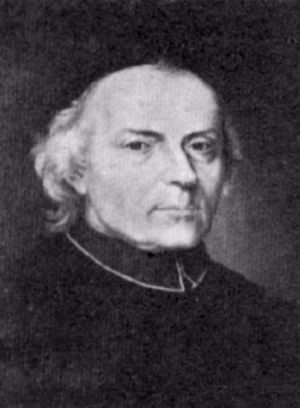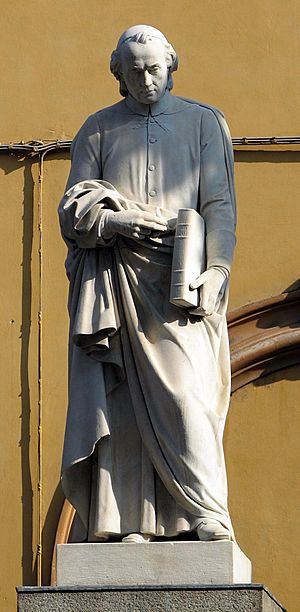Ludovico Antonio Muratori facts for kids
Quick facts for kids
Reverend
Ludovico Antonio Muratori
|
|
|---|---|
 |
|
| Born | October 21, 1672 Vignola, Duchy of Modena and Reggio
|
| Died | 23 January 1750 (aged 77) Modena, Duchy of Modena and Reggio
|
| Nationality | Italian |
| Occupation | Catholic priest, historian, librarian, philologist |
| Known for | Discovery of the Muratorian fragment, the earliest known list of New Testament books |
| Parent(s) | Francesco Antonio Muratori and Giovanna Muratori (née Altimanni) |
| Academic background | |
| Alma mater | University of Modena |
| Doctoral advisor | Gerolamo Ponziani |
| Influences | Benedetto Bacchini Carlo Maria Maggi |
| Academic work | |
| Discipline | Historian |
| Sub-discipline | Medievalist |
| Institutions |
|
Lodovico Antonio Muratori (born October 21, 1672 – died January 23, 1750) was an important Italian Catholic priest and a brilliant scholar. He was famous as a historian and for finding the Muratorian fragment. This fragment is the oldest known list of books in the New Testament part of the Bible.
Contents
Early Life and Education
Lodovico Antonio Muratori was born into a family that wasn't rich in Vignola, a town near Modena, Italy. He first learned from the Jesuits, who are a religious order. Later, he studied law, philosophy, and theology at the University of Modena. He became a priest in 1694.
A Career in Libraries and History
In 1695, a man named Count Charles Borromeo invited Muratori to work at the Ambrosian Library in Milan. There, Muratori immediately started collecting and publishing old, unedited writings. His first major work was Anecdota Latina, which means "Latin Unpublished Works." It was published in four volumes between 1697 and 1713.
Working as a Ducal Librarian
In 1700, Duke Rinaldo I appointed Muratori as the main archivist and librarian for the Ducal Library in Modena. Muratori kept this important job until he passed away. In 1716, he also became the leader of the Santa Maria della Pomposa parish, a church in Modena. He led this church until 1733.
Muratori continued to publish more old writings, including Anecdota græca (Greek Unpublished Works) in 1709. He also loved literature and wrote books like Della perfetta poesia italiana (On Perfect Italian Poetry) in 1706. He even tried to create a group for Italian writers and scholars.
Historical Research and Discoveries
In 1708, a disagreement happened between the Holy See (the Pope's government) and the Dukes of Este. This argument was about who owned the land of Comacchio. Muratori used his historical research to support the Duke of Este. He later used this research for his book Antichità Estensi ed Italiane (Este and Italian Antiquities), published in two volumes in 1717 and 1740.
Muratori spent a lot of time studying old documents to write a history of Italy. His biggest work was Rerum italicarum Scriptores (Writers on Italy). This huge collection of writings covered Italian history from 500 AD to 1500 AD. It was published in 28 large books between 1723 and 1751.
Important Collections and Canons
Muratori also put together 75 essays on different historical topics in his work Antiquitates italicæ medii ævi (Italian Antiquities of the Middle Ages). This collection helped explain and add to his work on historical sources.
In the third volume of this collection, he included the Muratorian Canon. This document is very important because it's one of the earliest lists of books that belong in the New Testament of the Bible. To make his research easier for more people to read, Muratori published a new Italian version called Dissertazioni sopra le Antichità italiane (Discussions on Italian Antiquities) in 1751.
He also collected ancient inscriptions in Novus thesaurus veterum inscriptionum (New Treasury of Ancient Inscriptions) and edited Roman Sacramentaries (old prayer books) in Liturgia romana vetus (Old Roman Liturgy). He wrote a timeline of Italian history called Annali d'Italia (Annals of Italy) in 12 volumes, based on all the sources he had found.
Views and Debates
Muratori wrote a book called De ingeniorum moderatione in religionis negotio (On Moderation of Minds in Religious Matters) in 1714. This book discussed how much freedom people should have in their religious thoughts. Some of his ideas were openly debated, especially those about certain religious beliefs and how saints should be honored. He defended his views in another work, De superstitione vitanda (On Avoiding Superstition). He also wrote about Christian kindness in Della carità cristiana (On Christian Charity).
Later Works and Legacy
Muratori continued his studies in literature, writing about famous figures like Petrarch and Lodovico Castelvetro. He also wrote books on philosophy, such as Filosofia morale esposta (Moral Philosophy Explained) and Delle forze dell' intendimento umano (On the Powers of Human Understanding).
He also wrote about law and politics, including Governo della Peste (Government of the Plague) and Della pubblica felicità (On Public Happiness). Muratori corresponded with many people, and his letters were later collected and published. Even though some of his religious and political ideas were debated, he was highly respected by important figures in the Catholic Church, including Pope Benedict XIV.
Muratori was also a member of the first learned society in lands ruled by the Austrian Habsburgs. His nephew, Giovanni Francesco Soli Muratori, followed in his footsteps and became the librarian of the Ducal collections after him.
In 1950, Italy honored him by issuing a postage stamp on the 200th anniversary of his death.
Images for kids
See also
 In Spanish: Ludovico Antonio Muratori para niños
In Spanish: Ludovico Antonio Muratori para niños




